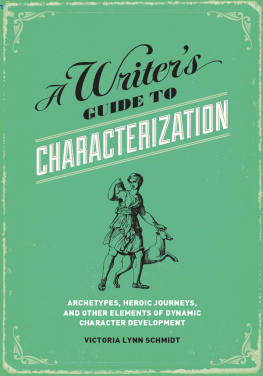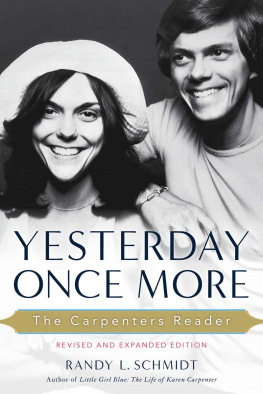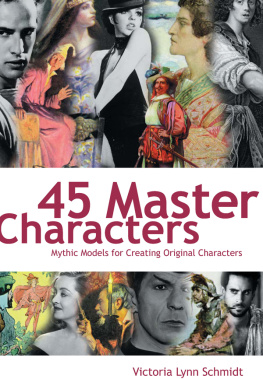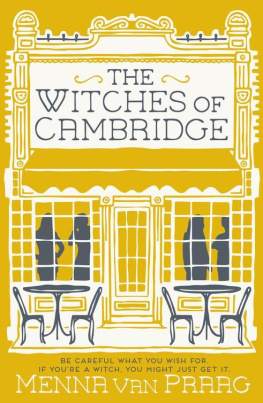A Writers
GUIDE TO
CHARACTERIZATION

ARCHETYPES, HEROIC JOURNEYS,
AND OTHER ELEMENTS OF DYNAMIC
CHARACTER DEVELOPMENT
VICTORIA LYNN SCHMIDT

DEDICATION
To my familyStephen, Sandra, Angela, Kimberly and Barbarathanks for sharing your archetypes with me and for all of your encouragement.
TABLE OF CONTENTS
PART 1:
ARCHETYPES & HOW THEY INTERACT
CHAPTER 1
Female Heroes and Villains
CHAPTER 2
Female Interactions
CHAPTER 3
Male Heroes & Villains
CHAPTER 4
Male Interactions
CHAPTER 5
Romantic Relationships
PART 2:
ANIMAL ARCHETYPES
CHAPTER 6
Animals as Archetypes
CHAPTER 7
The Bear: Patience & Connection
CHAPTER 8
The Buffalo: Gratitude & Trust
CHAPTER 9
The Cougar: Assertiveness & Mastery
CHAPTER 10
The Coyote: Curiosity & Resourcefulness
CHAPTER 11
The Deer: Innocence & Awareness
CHAPTER 12
The Dolphin: Transcendence, Harmony & Purpose
CHAPTER 13
The Fox: Cleverness & Resourcefulness
CHAPTER 14
The Horse: Freedom & Victory
CHAPTER 15
The Whale: Normalcy & Self-Acceptance
CHAPTER 16
The Wolf: Individuality & The Group Dynamic
CHAPTER 17
The Eagle: Deep Relationships & Patriotism
CHAPTER 18
The Hummingbird: Finding Inner Peace
CHAPTER 19
The Tiger: Mysticism & Kingship
CHAPTER 20
The Snake: Transformation, Death & Rebirth
CHAPTER 21
The Butterfly: Joyful Transformation

INTRODUCTION
The moment you think you understand a great work of art, its dead for you. O SCAR W ILDE
T he main goal of this book is to show you how to add that special element to your writing that will make it stand out from the rest, and maybe even inspire readers to call it a classic. Most of you know how to plot and how to create a basic character. You may have written a book or two, but to be great at your craft you need tools and techniques that will conjure deeper meaning from your work. I hope this book helps you do that.
Why should you strive for more meaning in your work? Meaning, which is sometimes called message or theme, is what readers and audiences really want from a piece of writing, though they may not consciously acknowledge it. When readers sit down to give you their precious time, they are hoping to be uplifted, to learn, to grow, as well as to be entertained. Many of you have the entertainment part down, but now you need to go a bit deeper.
Meaning and message can be a very subjective thing. Your goal is not to impart the correct meaning/message/subtext/theme but to inspire your reader or audience to think deeply enough to contemplate it. You want to engage readers on that deeper level. Its up to them to see things in their own way, through the lens of their personal experience and desires.
Meanings are not determined by situations, but we determine ourselves by meanings we give our situations.
ALFRED ADLER
The first section of A Writers Guide to Characterization covers many new ideas that I borrowed from Jungian thought and applied to the task of creating great characters. These ideas include the following:
More Jungian typology to add a bit more layering to the archetypes
Female archetypal interactions
A questionnaire to help you select a female archetype
Male archetypal interactions
A questionnaire to help you select a male archetype
Male and female archetypal interactions
Through the years I have met so many wonderful authors in the romance-writing genre, and I realized that none of these writers develop the romantic journeys in their books. So I set out to dissect the stories and to present the three main love plotlines one can follow in any genre of writing. Love concerns all people, and I believe writers can benefit by exploring it in the context of their art. So this book includes a section that delves into The Three Romantic Journeys.
I personally have studied many holistic areas of self-help and growth, and I have a deep affection for animals. Thanks to my studies, I found a whole new area of archetypes that I know will be of profound use to writers: that of the animal archetype. The lessons here will show you how your characters, viewed as animal archetypes, can create meaning and themes in your work. This book includes fifteen animal archetypal lessons.
A NOTE ON GENDER: I strive to alternate between the pronouns he and she for balance in the book. My use of a specific pronoun does not mean the information applies only to the gender mentioned. Both genders can cross over into any type.
PERSONALITY TYPOLOGY
The least of things with meaning, is worth more in life than the greatest of things without it. Carl Jung
While Jung is known primarily for his work on archetypes, he also developed a personality typology that sheds light on how humans approach life. This typology focuses on two types: Introverts and Extroverts. Within these two types each individual also uses one (or more) of four functions as a primary way of dealing with information and circumstances that come his or her way. The four functions are: sensing, thinking, intuiting, and feeling.
What follows is an overview of the four functions and how each one applies to writing and to individual archetypes.
Introversion or extroversion will act as the core of your character and determine how that character relates to the outside world and how other characters see him in this relating.
The functions will show you how your character is experiencing or taking in the information and circumstances of the plot as he faces them. They also help you make decisions on dialogue, clothing, mannerisms, style, and inner monologue, and thereby give you a solid framework from which to build well-rounded characters that are consistent. The functions offer another level to consider when using archetypes, though you can use them without archetypes if you want to.
Archetypes give you the deepest level of characterization, and these elements help you further focus and externalize archetypal qualities. In the best case, archetype comes first.
INTROVERSION AND EXTROVERSION
Introverts prefer the internal world of thoughts, feelings, fantasies, and dreams. Extroverts prefer the external world of things and people and activities.
FOR WRITERS: This means that a character that is extroverted will enjoy being around people and being outdoors. She will probably enjoy being in the spotlight more than an introvert will and she will be much more willing to speak in public. This type of personality is suited to a character such as an actor, dancer, leader, or politician.


















